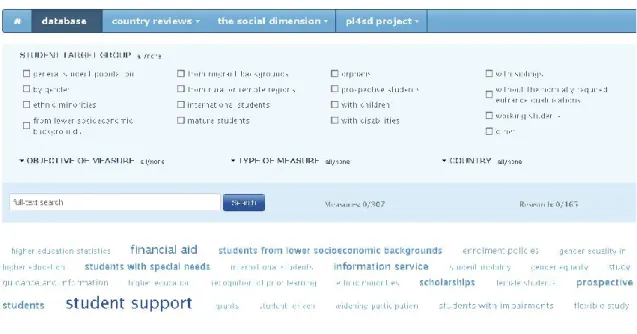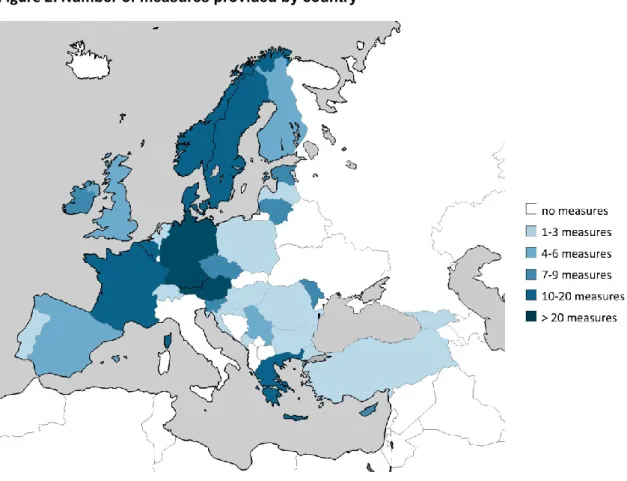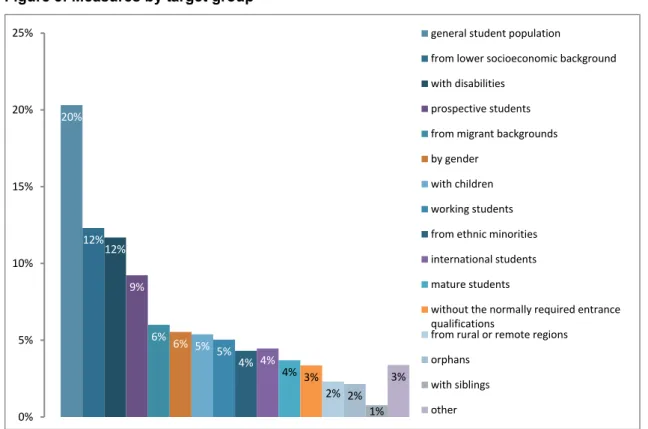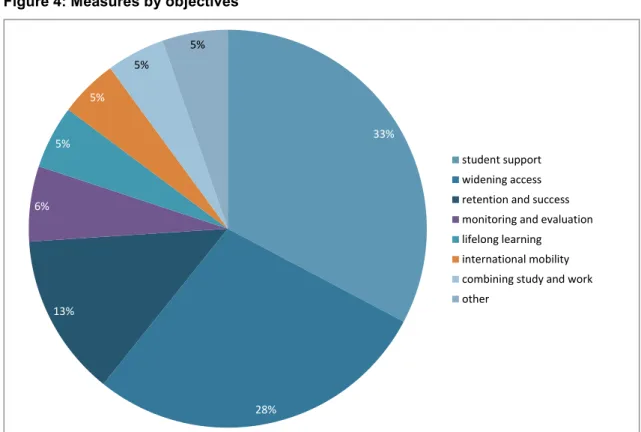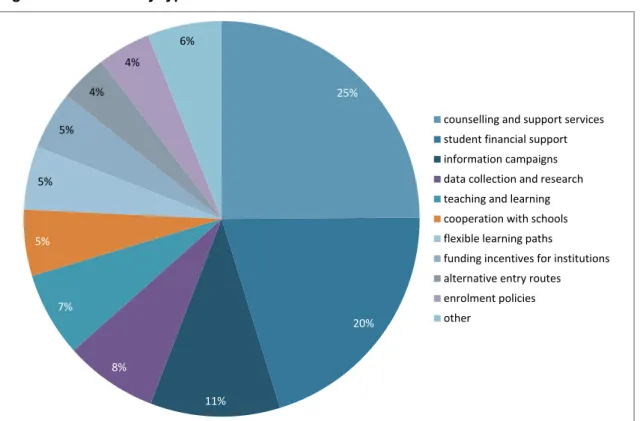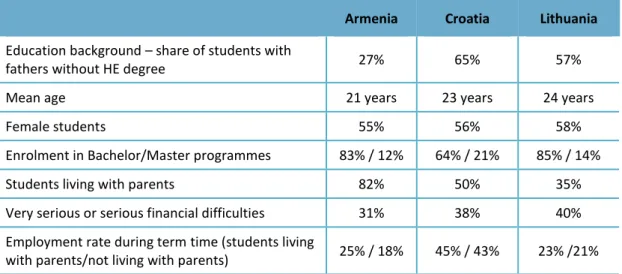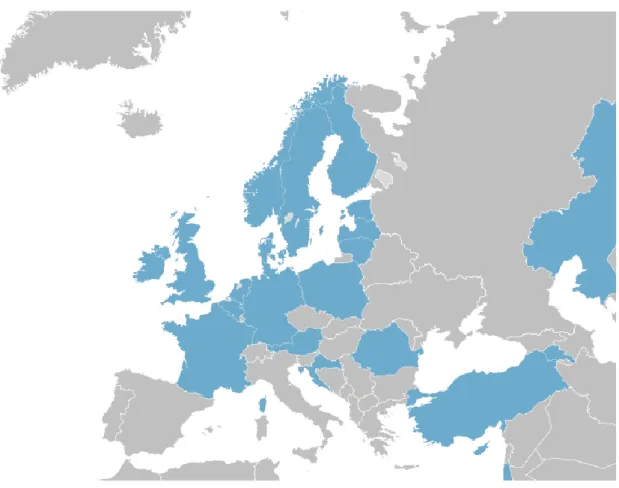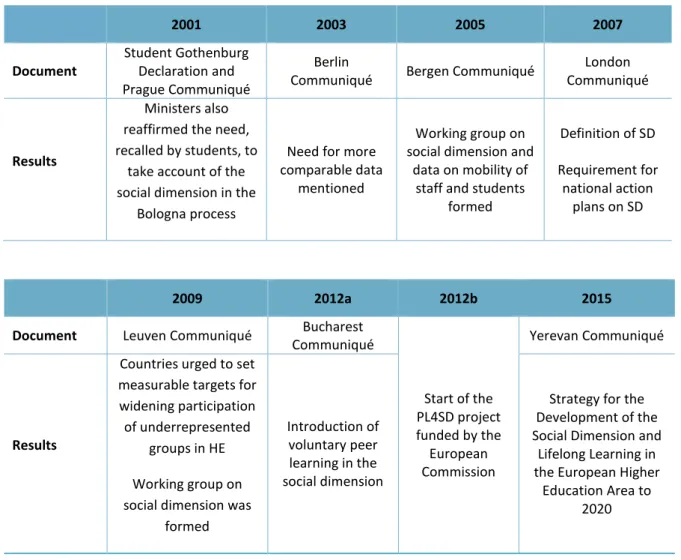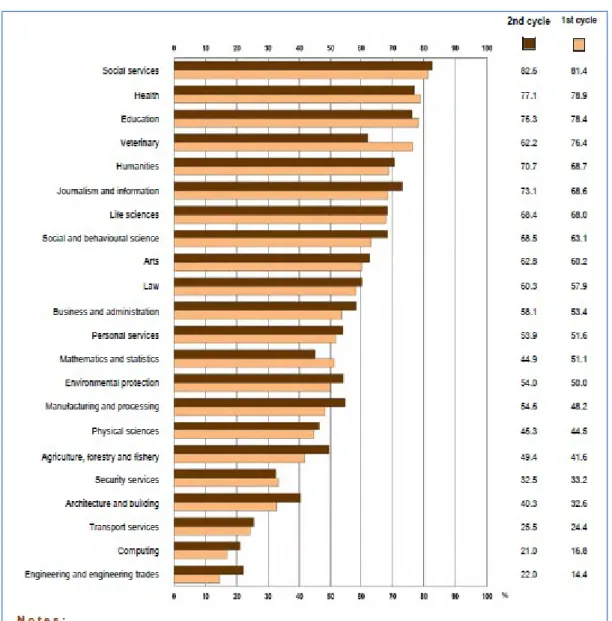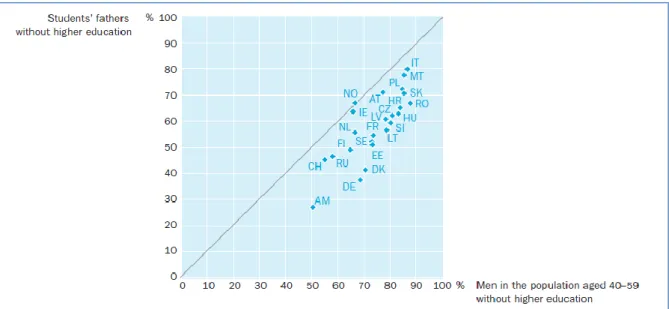with the support of the Lifelong Learning Programme of the European Union
Final project report
December 2015
Institute of Advanced Studies (IHS)
Josefstädter Straße 39, 1080 Vienna, Austria Email address: info@pl4sd.eu
Phone number: +43 1 599 91 133
This project has been funded with support from the European Commission. This communication reflects the views only of the author, and the Commission cannot be held responsible for any use which may be made of the information contained therein.
The Project Consortium
Austria:
Institute for Advanced
Studies Vienna (IHS; coordinator)
Martin Unger Sarah Zaussinger Petra Wejwar Andrea Kulhanek Iris Schwarzenbacher
Croatia:
Institute for the Development of Education (IDE)
Ninoslav Šćukanec Thomas Farnell Matija Sinković
Germany:
German Centre for Research on Higher Education and Science Studies (DZHW)
Dominic Orr Melinda Szabo Shweta Mishra
Belgium:
European Students’ Union (ESU)
Taina Moisander Elisabeth Gehrke Lea Meister Stela Stancheva
Contents
1 Introduction 4
2 Policy measures for the social dimension in higher education: The database 7
2.1 Development of the database 7
2.2 Value of the database: Who profits? 8
2.3 Content of the database 9
2.3.1 Policy measures 9
2.3.2 Country profiles 10
2.3.3 Research publications 10
2.4 Trends and patterns 11
2.4.1 Target groups 11
2.4.2 Objectives of the measures 13
2.4.3 Types of measures 14
2.5 Future prospects 15
3 Three case studies: The country reviews 16
3.1 The three countries 17
3.1.1 Common challenges and recommendations 18
3.1.2 Country specifics 21
3.1.3 Country responses to reviews 23
3.2 Lessons Learned from the country reviews 24
4 Peer learning in practice: The conferences 26
4.1 PL4SD Conference on Peer Learning on the Social Dimension in the EHEA 27 4.2 The Social Dimension in European Higher Education – Joint Conference of PL4SD and
EUROSTUDENT 29
5 Contribution of PL4SD to the social dimension in the EHEA 30
5.1 Development of the social dimension in the EHEA 30
5.2 Defining the social dimension and underrepresented groups: A challenge 32 5.3 Future prospects: Developing coherent national social dimension polices 35
5.4 Lessons learned from PL4SD 37
6 Plans for the future of PL4SD 39
7 References 41
7.1 Selected PL4SD documents 43
1 Introduction
The project Peer Learning Initiative for the Social Dimension (PL4SD) was a three-year project (2012-2015) funded by the European Commission through the Lifelong Learning Programme (Erasmus Multilateral projects). The project was driven by the notion of improving the social dimension in higher education through peer learning between the European Higher Education Area (EHEA) countries. The “social dimension” entails looking at various stages of the education system and adopting measures which can help individuals to overcome any barriers or disincentives to access, participate in and complete higher education. The intention is that the share of people participating in higher education should reflect the diversity of the general population. This was most clearly defined for the Bologna Process in the London Communiqué of 2007, having first been expressed in the Prague Communiqué of 2001. The London Communiqué states:
“We share the societal aspiration that the student body entering, participating in and completing higher education at all levels should reflect the diversity of our populations. We reaffirm the importance of students being able to complete their studies without obstacles related to their social and economic background. We therefore continue our efforts to provide adequate student services, create more flexible learning pathways into and within higher education, and to widen participation at all levels on the basis of equal opportunity.” 1
The PL4SD project was set up following the initiative of the 2009-2012 Bologna Social Dimension Working Group, which stressed the importance of peer learning among the stakeholders as a way of improving the social dimension across the EHEA. It was noticed that, although many measures to improve the social dimension are being realized, there is an information gap on what is really happening on a national, regional/local and institutional level. Social dimension measures are often scattered across the portfolios of different ministries and institutions with no broad, systematic overview available. EHEA Ministries responsible for higher education recognized this as a challenge and supported the efforts to develop peer learning on the social dimension, as stated in the Bucharest Communiqué of 2012:
“We encourage the use of peer learning on the social dimension and aim to monitor progress in this area.”
Given this recognition, PL4SD sought to bridge this information gap by systematically collecting data on measures to improve the social dimension, making this data readily accessible and initiating discussion and peer learning on the social dimension among policy- makers and practitioners.
1 All communiqués mentioned can be accessed at: http://www.ehea.info/article-details.aspx?ArticleId=43.
The challenge of fostering peer learning among EHEA countries was approached in the project using three core elements:
building up and maintaining an online database of measures,
conducting country reviews in three selected countries and assisting them in merging their national measures and initiatives into a coherent strategy, and
stimulating peer learning among EHEA stakeholders.
These three elements became the three pillars of PL4SD: database of measures, country reviews and dialogue through conferences.
3 Pillars of PL4SD
The aim of this report is to present an overview of the achievements of the PL4SD project activities, to encourage policy-makers and stakeholders in higher education to further develop peer learning for the social dimension and to educate policy-makers and stakeholders on the various approaches for addressing the social dimension and the possibilities of peer learning. Based on the PL4SD database (www.pl4sd.eu), this report provides insight into policy measures that have been implemented across the EHEA to address the social dimension, with special attention given to innovative policy measures. As the first pillar of the project, this database is the central tool for peer learning. It provides access to more than 300 measures from 33 countries and 165 research papers and reports on various aspects of the social dimension in higher education as well as brief country profiles on the social dimension for each EHEA country. It also offers users the possibility to comment on the measures in the database and thus initiates communication between various stakeholders.
The three country reviews conducted as part of the project supplied the PL4SD team with detailed information on different national contexts and allowed us to provide general recommendations on how to develop national strategies for the social dimension. In this report, we will focus on what we have learned about the process of discussing, analysing and planning policy measures for the social dimension in different national contexts.
Common challenges will be identified and potential solutions and approaches proposed.
Based on the project outcomes and their analysis, we will provide recommendations on how to use peer learning to foster the improvement of the social dimension. The two conferences held during the project formed an important part of this process. They provided the space for researchers, policy-makers, practitioners and other stakeholders to share their knowledge and ideas on how to improve the social dimension across Europe.
These conferences were also used to present and discuss the PL4SD project results and to improve them based on the input provided.
Last, but not least, this report should serve as the basis for the further development of peer learning in the social dimension. We believe that there are numerous ways to improve the existing database, to learn from the existing and future country reviews and to encourage discussion and cooperation between countries, ministries, policy researchers, higher education institutions, students and other stakeholders. Following the Strategy for the Development of the Social Dimension and Lifelong Learning in the European Higher Education Area to 2020, which EHEA member countries committed to in the Yerevan Ministerial Communiqué of 2015, we strongly support the efforts of the BFUG to continue developing and promoting peer learning as a tool for devising new and innovative policy solutions for developing the social dimension in higher education.
2 Policy measures for the social dimension in higher education: The database
One of the core elements of the Peer Learning Initiative for the Social Dimension is the PL4SD database pl4sd.eu. It contains:
(a) more than 300 policy measures aimed at improving the social dimension in higher education provided by countries and other relevant stakeholders;
(b) brief country profiles on the social dimension for each country in the European higher education area (EHEA);
(c) a broad collection of recent research on the social dimension.
The database enables peer learning among stakeholders and countries in order to improve the social dimension in higher education. Decision-makers throughout Europe are thus encouraged to start initiatives, measures and strategies that foster participation, access and equity in higher education.
2.1 Development of the database
In order to provide a highly intuitive and user-friendly database structure, a great deal of effort was put into the development of the database design. This included the development of an elaborate analytical grid and a corresponding questionnaire for stakeholders in higher education. These questionnaires were used to collect information on measures or initiatives undertaken by a country, region or organisation/institution. Many stakeholders were involved in the development of the database structure (e.g. the Bologna Follow-up Group, BFUG) and provided us with the benefit of their expertise and experience. Both the analytical grid and the questionnaire were revised several times based on the feedback received. This process resulted in a well-structured final version of the web interface. The interface ensures optimal usage for users who know what they are looking for. In addition, it includes elements like a “word cloud” to offer inspiration to users who do not yet know exactly what they are looking for.
Figure 1: PL4SD database search tool
Source: PL4SD database, www.pl4sd.eu
The database includes the following information on each measure: description of the measure; impact; overall assessment; keywords for searching the database; and other information. In addition, each measure is classified in three categories: (a) target group, e.g. ethnic minorities, working students; (b) objective of the measure, e.g. widening access, lifelong learning; (c) type of measure, e.g. student financial support, enrolment policies.
In three rounds of data collection between 2013 and 2015, the questionnaire was completed by ministries and other stakeholders (e.g. higher education institutions or student unions). As a result, more than 300 policy measures were included in the database.
As the quantity aspect was achieved, a commenting tool was developed and promoted in order to ensure the quality and significance of the data. All stakeholders were encouraged to comment on measures already included in the database and add information regarding their actual functioning and effectiveness.
In addition to the policy measures, the database section on research on the social dimension was updated regularly by the PL4SD team throughout the project based on desk research. In 2015, brief country profiles were also added to the database in order to provide an overview of the social dimension in each EHEA country’s higher education system.
2.2 Value of the database: Who profits?
The PL4SD database contains a broad scope of policy measures aimed at improving the social dimension in higher education. Many different stakeholders, including ministries, higher education institutions and national as well as local student unions, from all over Europe contributed their experience. Hence, the collection is very diverse and includes many innovative ideas targeting participation, access and equity in higher education. Due to
its comprehensiveness and variety, the database can serve as inspiration for all stakeholders in the EU and beyond who are concerned with the social dimension. Anyone interested in developing measures, initiatives or strategies to foster the social dimension can extract ideas from the database and its broad content. The well-structured search tool serves anyone who is looking for ideas and experiences made by other stakeholders. The database is a solid foundation for peer learning among different stakeholders from different countries and with different levels of experience. In particular, higher education policy-makers, higher education institutions and student unions can profit from its content.
2.3 Content of the database
The PL4SD database provides access to a broad range of policy measures and research publications as well as a country profile for each EHEA country.
The database content in numbers 1 database
3 main categories: objective, target group and type of the measure 8 categories of objectives
11 types of measures 16 target groups
33 participating countries 48 country profiles 165 research publications 307 policy measures
2.3.1 Policy measures
The database contains more than 300 policy measures aimed at improving the social dimension in higher education. These measures were provided by 33 countries in the EHEA. The number of measures included for each country ranges from 1 (e.g. for The Netherlands) to 87 (e.g. for Germany) measures. Countries that supplied information on more than 10 measures are: Austria (11% of all measures), Denmark (6%), France (5%), Germany (28%), Greece (4%), Norway (4%) and Sweden (6%). The map shown in Figure 2 indicates a slight trend with regard to the geographic distribution of measures, namely that more measures are provided by countries in north-west Europe. However, this does not necessarily mean that these countries pursue more extensive social dimension policies than other countries (see Chapter 2.4 for details).
Figure 2: Number of measures provided by country
Source: Own calculations, PL4SD database, www.pl4sd.eu
2.3.2 Country profiles
The policy measures in the database provide a good insight into the many social dimension initiatives across Europe. However, the composition of these measures does not reflect the social dimension policies and strategies of the EHEA member states in a comparable manner. Accordingly, a brief country profile was developed for each EHEA country in order to provide an overview of the social dimension in higher education in the entire Bologna area. These profiles provide information on overall strategies and policies regarding the social dimension, the composition of the student body, as well as tuition fees and student support in the respective country.
2.3.3 Research publications
In addition to policy measures, the PL4SD database provides a wide range of information on research publications regarding the social dimension in higher education and contains both book recommendations as well as journal articles and international reports on this topic. Altogether, it provides access to a collection of 165 research publications. Most of the research publications collected in the database address the general student population (20% of all publications), students with a lower socioeconomic background (16%), students with disabilities (12%), and students from ethnic minorities (11%).
2.4 Trends and patterns
The database contains innovative ideas and should be considered as a broad collection of examples for various social dimension initiatives. However, the measures provided in the database are not necessarily representative for a country’s overall social dimension policy.
While numerous stakeholders and policy-makers were given the opportunity to complete the questionnaire, they were under no obligation to do so. As a result, some stakeholders contributed several measures, while many provided none at all. Thus, the number of measures included for a given country does not necessarily mean that that country has extensive (in the case of a high number) or insufficient (in the case of a low number) strategies in place. In some cases, the absence of measures can also be the result of an absence of problems. Likewise, similar policy measures to those provided by some countries may also exist in others, yet not be defined there as higher education policy. As a result, such measures may not have been submitted for inclusion in the database as they were covered by other policy areas (e.g. support for orphans). In addition, the scope of the measures in the database differs widely and ranges from state scholarship programmes to student welcome days organised by local student unions. This diversity complicates the comparability of measures but has to be seen as essential strength of the database, ensuring that it serves as a fruitful tool for many stakeholders on different levels.
Hence, the composition of measures does constitute a representative reflection of a country’s social dimension policy. This makes it very difficult to identify trends and patterns based on the database content. Nonetheless, a closer look at the measures provided by various countries does still reveal some interesting trends. However, as explained above, the findings have to be interpreted with caution.
2.4.1 Target groups
The measures provided in the database aim at supporting various target groups. Of the 16 target groups mentioned, most measures address the general student population (20% of all measures; 27 of 33 countries), students from a lower socio-economic background (12%; 26 of 33 countries), students with disabilities (12%; 22 of 33 countries) and prospective students (9%; 17 of 33 countries).
Figure 3: Measures by target group
20%
12%12%
9%
6% 6% 5% 5%
4% 4%
4% 3%
2% 2%
1%
3%
0%
5%
10%
15%
20%
25% general student population
from lower socioeconomic background with disabilities
prospective students from migrant backgrounds by gender
with children working students from ethnic minorities international students mature students
without the normally required entrance qualifications
from rural or remote regions orphans
with siblings other
Source: Own calculations, PL4SD database, www.pl4sd.eu
The database contains a fairly high number (36) of measures that target gender imbalances.
However, these 36 measures all stem from only 5 countries in total, i.e. from only a very few countries. Of note here is the fact that all measures aiming at gender equality are from countries in north-west Europe, predominantly the German-speaking countries.
Students with a migrant background are another group mostly targeted through measures contributed by north-western European countries. Likewise, most measures for students without the normally required entrance qualifications also stem from north-west Europe.
Another observation regarding geographical distribution concerns measures targeting orphans and students with siblings. Both these groups are mostly targeted by measures from countries in south-east Europe.
Example from Estonia: “Free studying for young parents”
Target group: students with children
The objective of this measure is to counteract demographic population decline. Furthermore, this measure gives young parents the chance to continue with their studies: universities cannot charge tuition fees to students who are taking care of a child under 7 years of age or a child with a disability.
2.4.2 Objectives of the measures
In addition to the categorisation according to target group, the measures in the database are also structured by objective. A total of 8 categories are used here. A majority of the measures aim at supporting students (33% of all measures; 32 of 33 countries) or widening access to higher education (28%; 28 of 33 countries), followed by the objective of fostering retention and success (13%; 21 of 33 countries).
Figure 4: Measures by objectives
33%
28%
13%
6%
5%
5%
5%
5%
student support widening access retention and success monitoring and evaluation lifelong learning
international mobility combining study and work other
Source: Own calculations, PL4SD database, www.pl4sd.eu
The lowest numbers of measures address the objectives “combining study and work”, and
“international mobility”. In both cases, only 24 such measures (5% of the total number of measures) were submitted to the database.
Looking at the composition of measures by objectives, no clear patterns are noticeable regarding the geographical distribution of measures.
Example from UK: “The FORMULA Project”
Objective: widening access, student support
The project is training adult role models, who have previously returned to learning, to become mentors for those who have not yet taken this step. The idea is that these mentors will be role models for others from deprived areas and backgrounds to encourage them to enhance their opportunities for education and eventual employment. This should result in an uptake in education by this group and an improvement in self-esteem and confidence as they realise that they can develop useful skills and knowledge.
2.4.3 Types of measures
The database is structured into 11 types of policy measures. Most of the measures are in the area of counselling and support services (25%; 22 of 33 countries), student financial support (21%; 30 of 33 countries) and information campaigns (11%; 17 of 33 countries).
Figure 5: Measures by type
25%
20%
11%
8%
7%
5%
5%
5%
4%
4%
6%
counselling and support services student financial support information campaigns data collection and research teaching and learning cooperation with schools flexible learning paths
funding incentives for institutions alternative entry routes enrolment policies other
Source: Own calculations, PL4SD database, www.pl4sd.eu
Of the types of measures included in the database, the lowest number of countries (9 in total) contributed measures relating to the area of funding incentives for institutions.
A geographical distribution trend is evident with regard to measures in the teaching and learning category. Most of the 13 countries which provided teaching and learning measures (31 in total) are located in north-west Europe.
Example from Austria: “Try studying”
Type: counselling and support services, information campaigns
The Austrian students’ union offers prospective students the opportunity to see behind the curtain of a study programme they are interested in. Accompanied by a university student, prospective students attend a selected course at the higher education institution of their choice. Each participant can subsequently ask further questions in a personal consultation session. Although the measure primarily targets school pupils, it is also accessible to all other interested persons. “Try studying” aims at decreasing dropout rates by helping prospective students to identify their study programme of choice in the first place.
2.5 Future prospects
The PL4SD database already serves as a broad idea and knowledge pool for policy-makers, higher education practitioners and other stakeholders. It represents a basis for effective peer learning on social dimension policies throughout the EHEA. In order to strengthen the peer learning process and preserve the support for relevant stakeholders tackling national challenges, the database should be further expanded. In particular, more of the stakeholders concerned should be encouraged to comment on existing database measures, thereby enhancing the quality and significance of the data.
The PL4SD database supports stakeholders in fostering access to and participation and equity in higher education. This role should be maintained in future in order to further strengthen peer learning on the social dimension in higher education.
3 Three case studies: The country reviews
The second pillar of the PL4SD initiative are the three detailed country reviews that were carried out as a pilot study to show how countries can benefit from external expert reviews.
With the help of the Bologna Secretariat, all Bologna Process member countries were invited to participate in a national expert review of the social dimension of higher education. Three countries, Armenia, Croatia and Lithuania voluntarily accepted this invitation.
The PL4SD country reviews aim at providing an external and comprehensive reflection and review of initiatives and measures undertaken by a country to support the social dimension of higher education. The objective of the reviews is to assist the analysed country in the development of a coherent and effective national strategy for improving the social dimension of higher education. When taken together, the reviews also serve to inform other EHEA countries on the challenges faced in the reviewed countries and on the measures they have implemented to enhance the social dimension of higher education.
Thus, country reviews can also be seen as a tool for peer learning.
The three countries which voluntarily participated in the reviews should be seen as role models for countries which wish to look at their education system – and especially their higher education system – from the perspective of improving the social dimension of higher education. Both the project participants and the ministries involved are convinced that this type of review can lead to overall improvements in access to and delivery of higher education in the 21st century.
In coordination with the ministries responsible for higher education in the reviewed countries, the PL4SD team developed a framework for the review and agreed the terms of reference. The review process itself was split into three phases:
(1) the preparation phase: setting up the external review team and drafting the background report;
(2) the implementation phase: developing the schedule for the site visit and the on- site review (5 days);
(3) the final phase: drafting and finalising the review report
Each country review was conducted by an international review team made up of four members of the PL4SD consortium and three external experts, who were selected based on their wide-ranging experience in the assessment of national higher education systems and their understanding of social dimension issues. Collectively, their knowledge and experience enables them to sympathise with and comprehend the perspectives of policy- makers, higher education institution (HEI) representatives, researchers and students. The external experts were nominated by the PL4SD consortium and mandated by the Stakeholders’ Forum (made up of members of the Social Dimension and Lifelong Learning Working Group of the Bologna Process, 2012-2015).
3.1 The three countries
Armenia, Croatia and Lithuania, the three countries which participated in the pilot country reviews, are diverse in their social, economic, cultural and political backgrounds. Thus, the review process in each of the countries faced different contexts and different challenges.
Although the framework of the review and the topics covered were the same, the reviewers had to be sensitive to and aware of the specific national circumstances that had shaped the development of the higher education systems in the countries analysed.
Table 1: Student body in the reviewed countries
Armenia Croatia Lithuania Education background – share of students with
fathers without HE degree 27% 65% 57%
Mean age 21 years 23 years 24 years
Female students 55% 56% 58%
Enrolment in Bachelor/Master programmes 83% / 12% 64% / 21% 85% / 14%
Students living with parents 82% 50% 35%
Very serious or serious financial difficulties 31% 38% 40%
Employment rate during term time (students living
with parents/not living with parents) 25% / 18% 45% / 43% 23% /21%
Source: EUROSTUDENT V data.
Nonetheless, all three countries have shown interest in promoting the social dimension of higher education as a component that can contribute to the development of the higher education system on the whole. The review teams were pleased with the response and support received both from the national ministries and from the other institutions and stakeholders they met and interviewed during the on-site country visits. During these visits, the review team held discussions with ministry officials, student representatives, researchers, HEI representatives and various higher education (HE) agencies in each country. Interviews were also held with NGOs and the employment service (Croatia), with the employers’ union, international organisations, representatives from secondary education, members of the opposition party (Armenia), and with a special needs education organisation (Lithuania). Between 60 and 100 individuals were interviewed per country, either individually or in groups.
Prior to the country visit, a background report was prepared. This report included basic information and facts about the country, its higher education system and the social conditions of student life. After the visit, a final report, which included the review team’s recommendations, was sent to the respective national ministry for comment. After a revision of all documents, the background report, the final expert report and the response of the national ministry together form the PL4SD country report. All three country reports are published on http://www.pl4sd.eu/index.php/country-reviews/reports-by-country.
3.1.1 Common challenges and recommendations
As mentioned above, the higher education systems in the reviewed countries have developed in different social, economic and cultural contexts. Nevertheless, the reviews did uncover common challenges regarding the social dimension and some overarching issues, which will be discussed in this chapter.
All three review countries stem from the group of transitional countries that have been undergoing significant economic and social changes in the last two decades, These changes have also affected their higher education systems. Likewise, all three countries are members of the Bologna Process, which not only brings out similarities between reviewed countries, but also establishes a connection to other EHEA members and a basis for peer learning from the country reviews. Examples of peer learning can already be seen in the existing country reviews. For instance, guidelines for Croatian HEIs for supporting disabled students were suggested to Armenian HEIs as part of the model for creating inclusion strategies for underrepresented groups. There are also examples in the reviews of universities which are implementing measures for the inclusion of specific underrepresented groups. Other HEIs have the opportunity to learn from these practices and improve the progression of these groups in their institution.
3.1.1.1 Data collection
The systematic collection of data in higher education in general, and on the social dimension in particular, is frequently mentioned as a challenge. This varies from country to country but is the overarching issue that hinders evidence-based policy-making in some areas. For example, the lack of reliable data for Croatia is noted, specifically with regard to the amount and type of support that students receive. A lack of data was also noticed in Armenia, with an emphasis here on data relating to the social background of the students.
In Lithuania, the review team recommended that priority be given to the development of IT systems that track the performance and retention of all students in higher education. In general, providing reliable data through an easily accessible centralised information system is a prerequisite for all countries in order to enhance policy-making.
3.1.1.2 Merit- vs. need-based support
The criteria for receiving public student support is another overarching issue that is also somewhat controversial. Assessing merit – the students’ achievements before and during their studies – is deeply rooted in all three countries reviewed as the primary – and sometimes even sole – criteria for receiving public support, a fact that at times causes resistance towards more need-based student support. In Lithuania, for example, even the need-based support system is circumscribed by performance criteria requirements for retention of a grant. The situation is similar in Armenia, where the merit criteria mean that most of the student support is awarded to students who could have afforded to go to university even without this support. In Croatia, due to the small number of grants available, merit criteria prevail even if it is combined with the need criteria (although it is worth noting that there is a shift here towards a need-based system of national student support).
It is important to point out that reviewers are not against assessing and rewarding the academic achievements of students. Such incentives are important for supporting high quality education. On the other hand, providing direct financial support to those groups of students who cannot afford the costs of higher education is of utmost importance for improving social inclusion and the social dimension of higher education and, therefore, should be assigned priority.
3.1.1.3 Inequalities in pre-tertiary education
It is not surprising that one of the common challenges lies in dealing with inequalities in higher education before people get to that stage in their academic career. Socio-economic disadvantages are created much earlier, not only in the countries reviewed. Pre-tertiary education is therefore mentioned in the recommendations for improvement in all of the reviews. Favouring merit over social criteria is also an issue here because access to higher education is, in most cases, granted on the basis of prior school achievements. This is especially applicable in the case of access to state-funded higher education.
In Armenia, one major problem is that private tutoring has become the rule for more affluent pupils and is no longer just an exception for those with problems in learning.
Private tutoring is thus a major obstacle to ensuring that all pupils have an equal chance of access to higher education, and more needs to be invested in the country’s high schools to better prepare pupils for the national tests. This issue is less dramatic in Croatia and Lithuania, but socio-economic differences that determine success at secondary school success and entrance to higher education are also easily detectable in these two countries.
Differences in the quality of education between schools in different regions (i.e. rural vs.
urban areas) are visible in both countries as well as stratification through different secondary education tracks with different education outcomes (e.g. vocational vs. general education schools in Croatia).
Recommendations for tackling these challenges can be grouped into two approaches. The first such approach is to invest more in the quality of pre-tertiary education, placing a special focus on equity and intervention strategies to reduce the gap in performance between underrepresented and privileged groups. The second is to ensure that there are more alternative routes for access to higher education for disadvantaged groups and for pupils graduating from vocational schools. These two approaches are not mutually exclusive.
3.1.1.4 Alternative entry routes to higher education
The lack of alternative routes for entry into higher education is a frequently mentioned issue. In Armenia, for instance, there is a complete lack of alternative routes for those pupils who do not do well in the central examination. In Croatia, although the recently introduced State Matura provides at least formal equality, it also creates barriers for those who finished secondary education before it was introduced. Educational pathways (school) and family socio-economic background also affect qualification results. The development of alternative entry routes could help to tackle these issues. This recommendation is also valid for Lithuania, where alternative entry routes could be used as an incentive for
underrepresented groups. Second chance and alternative entry routes can be considered as a response to the socio-economic barriers that result in lower achievements in primary and secondary education and which, in turn, prevent access to higher education.
3.1.1.5 Social situation of students
Basic data on the student body in the reviewed countries (Table 1) shows that all three have a high ratio of students with very serious or serious financial difficulties (Armenia 31%, Croatia 38% and Lithuania 40%.) While this reflects the general economic situation in these countries, it also has implications for higher education policies, especially in the area of student support. One recommendation is for all three countries to improve the support provided to students both in terms of the award criteria (see above) and in terms of amounts awarded. The funding of higher education is likewise a challenge in all countries where balancing between increase in fees and public funding of HEIs is a sensitive topic.
In general, more public funding for the higher education system would be welcomed. The introduction of target-based funding of HEIs, e.g. for improving the social dimension through student support and other measures, might be part of the solution. Such programmes could channel public funds and, at the same time, increase the interest in the social dimension on the part of the HEIs.
3.1.1.6 National targets for underrepresented groups
Defining national underrepresented groups is the first step in creating strategies for inclusion and tackling inequalities. All of the reviewed countries have identified these groups and included them in their strategy documents and legislation. What is lacking is the next step: setting clear national targets and benchmarks to be achieved in defined time periods. Both Lithuania and Armenia were encouraged by the review team to set these targets as a clear indication of direction in the development and implementation of new policies. This type of benchmarking is necessary for creating and evaluating policy measures.
3.1.1.7 Division between vocational and academic education paths
One common trait of the reviewed countries is the lack of flexibility in changing education paths, specifically with regard to permeability between vocational education and academic higher education. Differentiation between general education and vocational schools at secondary level generates different opportunities for continuing higher education. In Croatia, the State Matura favours general education, and studying at vocational higher education institutions is financially more strenuous. In Armenia, only 10% of the student intake at HEIs can come from vocational colleges. In Lithuania, the reviewers also noted that there is little opportunity for students to change from the vocational to the academic education path. Accordingly, recognising the importance and value of vocational education for the local economy is important for the development of this form of education.
Likewise, the countries reviewed should develop alternative routes for entry into academic higher education. This would not only provide additional opportunities for entry into higher education for students who underachieve for socio-economic reasons, it would also
strengthen the lifelong learning process which, given the demographic trends (especially in Lithuania), will be of great importance for the sustainability of higher education.
3.1.2 Country specifics
Although the reviews identified major common challenges and issues which can be approached with similar solutions, each country also has its own specifics. Even when we talk about similarities between countries, we must bear in mind that the context in which the common challenges take shape are different. The three reviews made recommendations for each country on what to do to improve their higher education system, and the common points identified have been described above. Based on these recommendations, common strategic approaches can be adopted. However, the actual national strategies, actions plans and policy measures deployed will ultimately depend on the specifics of the situation in each individual country.
Each of the countries reviewed faces its own challenges and was also provided with specific recommendations that only apply to that country. In the following sections, we will sketch out these specifics. However, since the ultimate aim of this report is to describe the results of the PL4SD project as a whole, the details of each national context have been kept deliberately brief. For those who are interested, the country reviews and country background reports are available on the PL4SD website.
3.1.2.1 Armenia
The Armenian higher education system is characterised by high costs of studying. Tuition fee rates for the majority of students lie between 350 and 700 euros per semester, and only around 22% of all student places are non-fee-paying. Expenditure on student support is low, and most grants are awarded on the basis of merit. Nonetheless, education is very important in Armenia from a cultural perspective, and the participation rate (37% in 2011) is high despite the financial constraints. HE is generally underfunded (only 20% of the income of public universities comes from state support), and the Armenian diaspora plays a crucial role in financing study costs. There are national policies in place that are aimed at reducing inequalities (income-based criteria) with the goal of increasing the participation of underrepresented groups. These are still in the early stages of development, and it is recommended that Armenia continues its policy improvements through Erasmus+ and Tempus projects in order to improve data gathering, develop a less fragmented student support system, increase the sustainability of the HE funding system and develop an integrated strategy to decrease demand of private tutoring in high schools.
The list below details the specific recommendations made by the review team and which were not mentioned in the previous section. The review team recommended Armenia to:
collect data in anticipation of key policy questions using existing data collection practices and surveys to collect additional data;
develop a less fragmented student support system based on identified needs rather than on demonstrated ability;
include indirect support for accommodation, transport, counselling and other student services in the student support system;
recognise the sustainability and effectiveness of the higher education funding system from the perspective of the HEIs and the students;
cultivate cultural understanding and positive recognition of differences in terms of gender, identity (sexual, political and religious) and belonging (socio-economic background) in order to improve the social dimension of student life.
3.1.2.2 Croatia
In Croatia, there is a new “linear” tuition fee model in place. In this model, the fee amount is dependent on study progress. All first-year full-time students are exempt from fees. In general, expenditure on student support is low (12% of total HE expenditure), and the greater part of this expenditure is invested in indirect financial support. Underrepresented groups in HE in Croatia include students with a lower socio-economic status (SES) and mature students, while students following professional/vocational courses face more adverse study conditions. The differentiation between general and vocational schools generates different opportunities for moving on to higher education. The country review indicated that a lack of transparency with regard to the financial support system and the provision of merit-based rather than need-based support put students with a lower SES at a disadvantage. It was recommended that Croatia create a more unified system of data collection and that it shift from indirect to direct financial support and from merit-based to need-based financial support. It was also recommended that the country review the State Matura examination and the effects of the pre-tertiary education on inequalities in HE.
The list below details the specific recommendations made by the review team and which were not mentioned in the previous section. The review team recommended Croatia to:
create a more unified system of data collection;
conduct frequent small-scale research to uncover whether the intended effects of broad national strategies are really occurring or if unintended effects are emerging;
develop partnerships and peer learning between university centres with developed student support services and local and vocational HEIs which do not have such support systems in place;
provide greater and timely direct financial support through state scholarships;
recognise and support the key role which universities of applied sciences and regional HEIs play for the social dimension;
review the impacts of the State Matura examination;
continue to reform student support from an indirect to a direct support system;
see the social dimension as an evaluative framework of the overall performance of Croatian higher education.
3.1.2.3 Lithuania
The Lithuanian education system is highly stratified and merit based, starting with secondary education and continuing in HE. Although the system is transparent and fair in
terms of merit, it is questionable whether it offers equal opportunities. The review team recommended that Lithuania re-examine the merit-only based system of state funding and that it include the social dimension in its HE policies (including targeted funding, reserved places at HEI’s for certain target groups and alternative access routes). The cost of studying is among the highest in Europe, while income levels are amongst the lowest.
Tuition fees are determined by the HEIs and range from 1000 to 5,300 euros per year. 56%
of university students had to pay tuition fees in 2012.
The list below details the specific recommendations made by the review team and which were not mentioned in the previous section. The review team recommended Lithuania to:
include all stakeholders in the discussions on the social dimension and its national policy objectives;
introduce targeted funding to improve access of underrepresented groups by offering reserved places and/or alternative entry routes;
offer financial incentives for HEIs to develop innovative support programmes to boost the performance and retention of disadvantaged students;
use alternative entry routes to tackle the issue of the declining student base;
broaden the understanding of the underrepresented groups and develop proactive strategies at institutional level.
3.1.3 Country responses to reviews
In the period after the country reviews, the three countries had the possibility to act upon the recommendations, i.e. to reject or to try to implement some (or all) of them. At the final project conference in February 2015 in Vienna, representatives of the national ministries responsible for the higher education in the review countries had the opportunity to discuss the findings of the reviews and provide feedback on their current policy activities. In general, their feedback was positive. Both the representatives of the ministries and the members of the review teams voiced their satisfaction with the review process and the good mutual cooperation. Many of the findings of the reviews had already been taken seriously, and policy measures developed to apply the recommendations.
In Armenia, the social dimension in higher education is regarded as a policy priority, and the PL4SD report was a part of the country’s efforts to improve it. The ministry accepted the recommendations made by the review team and had indeed already realised some of them: a tertiary education information system has been launched and will be made publicly available, an assessment of the social needs of students had been conducted in 2014, Armenia intends to continue participating in the EUROSTUDNET survey, and a revision of secondary school curricula (financed by the World Bank) will be implemented in the period from 2015-2019. Strong attention will be given to the social dimension within the
“National Strategy for Education Development 2016-2025”.
In Croatia, the findings from the PL4SD review will be useful for the future and it was noted that they were in line with the national “Strategy for Education, Science and Technology”. It was stressed that the social dimension is seen as an important evaluative
tool of the overall performance of Croatian HEIs. The implementation of several projects funded through the Instrument for Pre-Accession Assistance (IPA) and aiming at the social dimension is currently underway. In addition, the social dimension is being strengthened through pilot schemes for funding HEIs through programme agreements. Croatia also plans to continue to participate in the EUROSTUDENT survey. The country’s new national grant scheme is based on need not merit, while grants based on achievements are awarded by the HEIs themselves. Perhaps the most important joint impact of both the PL4SD country review and the EUROSTUDENT survey was the recognition of the social dimension as an important policy topic. This has led to the forming of the National working group for the enhancing of the social dimension in higher education, which will play important role in monitoring and developing the social dimension in Croatian higher education in the future.
In the response from Lithuania, it was stated that although the merit-based system is functional to a point and hard to change, widening the participation of socially excluded groups is stipulated in the country’s law on HE and support for underrepresented groups and is delivered in accordance with national social policy through a number of national and regional institutions. The PL4SD project provided a useful external review that was needed to improve the understanding of the social dimension issues and is considered a good starting point for further developments (e.g. a strategy with goals on the social dimension is planned by the end of the 2015).
3.2 Lessons Learned from the country reviews
The country reviews were not intended to be read as reviews of the accomplishments of the individual countries, but as general insights into different contexts that can stimulate and inspire policies and measures directed towards the social dimension in higher education. Accordingly, there is as much to learn from the process of conducting the reviews as there is from their content.
A lot of recommendations referred to changes or policies that the ministries intended to do anyway. It is important to find a way to communicate this point to all of the stakeholders and to include them in the policy-making process. Many measures that affect the social dimension of higher education are scattered across different ministries or ministerial sectors and sometimes go unnoticed or are not consistently planned. There is a lack of common understanding of what constitutes the social dimension, and better communication among the stakeholders is one way to remedy that.
Preparing the country background report was a valuable exercise and provided the review team with insights not only on the national social and economic contexts, but also on the state of the country’s higher education in general and the social dimension in particular.
Thus, the review teams observed that if national groups were the ones who were to prepare such background reports in future, they would be more aware of the issues present.
Including major national stakeholders, especially the government and HEI representatives, in the preparation of the background report might have positive effects on raising awareness of the importance of the social dimension.
One major lesson learned from the country reviews that could be beneficial for all EHEA countries is that there are many similarities between countries, even among those that are very different in their social, economic, political and cultural aspects. Examples of good practice could be found in each of the reviewed countries along with ways of implementing and adjusting these practices in other contexts.
Additionally, a country review has at least limited effects on the country’s dedication to improving the social dimension. It seems that participating in the review process and collaborating with the review team raises awareness of the issues and inspires both learning and further efforts to bring about change through new policies. Of course, these remarks must be taken with caution because more time needs to pass before we can actually evaluate the real and long-term effects of the reviews.
4 Peer learning in practice: The conferences
An important part of the PL4SD project were the conferences held in Vienna during the project. Referring to these as the “third pillar” of PL4SD is not an exaggeration: they were a true platform for peer learning in practice between the various stakeholders. Researchers, practitioners and representatives of students, ministries and higher education institutions all shared their views on various aspects of the social dimension in higher education at these conferences. These different perspectives were beneficial in two ways. First, they steered the further development of the project, giving valuable feedback on the activities that were being carried out. Second, they provided the participants with an opportunity to hear about the various initiatives and measures for social dimension that have been implemented or are planned for implementation in the near future in different EHEA countries. The sharing of such information and practices is crucial for stimulating policy changes in different settings and offers the participants an opportunity to learn from each other’s experiences (both positive and negative).
